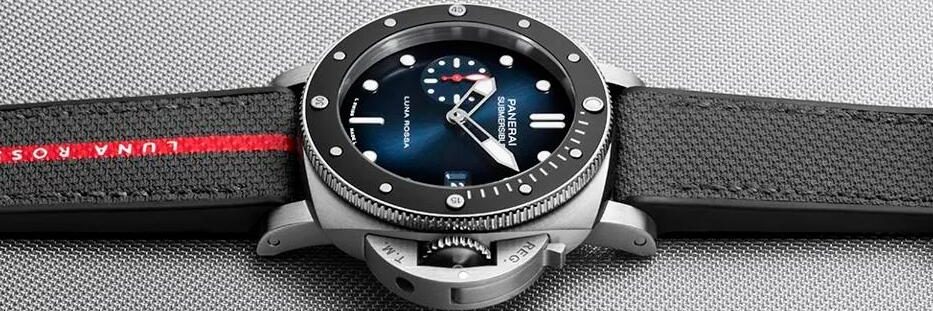The cheap replica Audemars Piguet Royal Oak Offshore limited edition watches dedicated to the world of Formula 1 are one of the most interesting chapters in the history of the Offshore collection, which turns 30 this year. The release of such Offshores did not last long, from 2004 to 2012. Many of us were there, but for many everything was somehow forgotten and it is worth refreshing memories.
Looking at the past is useful, not only to remember something you forgot or to find out what you missed but also to take a look at the past and re-evaluate what you once might have underestimated in the hustle and bustle of everyday life.
These thoughts came to mind as I gathered information for the planned publication cycle on Offshore’s history. I have sometimes been annoyed by the seemingly endless series of limited editions devoted to this and that. And not just me, I remember the opinion a certain collector once expressed on the subject: The Montoya or the second Barrichello are excellent high quality fake watches, but what was produced after that is not worth taking seriously.
Now the subject is closed: Offshores dedicated to Formula 1 have not been produced since 2013, and so this whole story takes on a clearly defined collector’s aura. However. it’s worth taking a closer look at FI racing Offshores – what a theme to collect! And look at the names: Michael Schumacher, Rubens Barrichello, Juan Pablo Montoya, Jarno Trulli, and Sebastien Buemi. A fairy tale.
2004, starring: Juan Pablo Montoya, the watch: Royal Oak Offshore ‘Juan Pablo Montoya’ Chronograph Ref. 26030PO.OO.D021IN.01, platinum, 44 mm, limited edition of 100 pieces.
Racing Offshores began in 2004 with a watch dedicated to Juan Pablo Montoya, not ‘Barrichello’ ROO, as is often reported. In 2004 Montoya was the talk of F1, the enfant terrible and a threat to the champions. The results of the 2002 and 2003 F1 seasons gave every reason to see him as the new superstar. Therefore, the choice of driver to participate in the launch of the first ROO F1 was impeccable and the result is impressive.
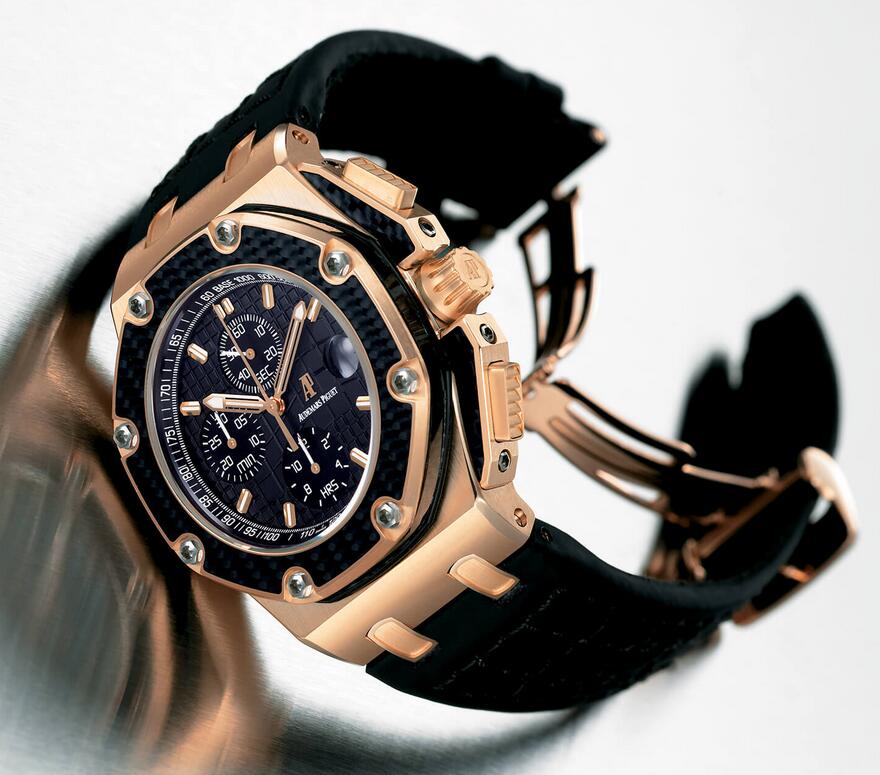
The rest i.e., the design, was the responsibility of Octavio Garcia, who was Audemars Piguet’s art director from 2002 to 2015 and who created the design of all the best UK replica watches in this report.
Octavio Garcia cannot be called a follower of laconic design. On the contrary, he seems to be a great master of numerous delicious details, with which he endowed the Swiss movements copy watches he drew so abundantly that sometimes it seemed too much. The ‘Montoya’ is both a first foray into the ROO F1 genre and an example of his style.
The first thing that caught my eye is that he changed the design of the Royal Oak’s signature octagonal bezel, which was a venerable relic for Audemars Piguet at the time. For the ROO ‘Montoya’ watch, Octavio Garcia replaced the RO standard white gold hexagonal screws with racecar-inspired titanium hollow-head screws, added side grooves for them in the bezel, and decorated the bezel with a carbon fiber insert.
In addition, Octavio Garcia enlarged the already visually massive Offshore case by adding angular guards for the chronograph pushers and crown (some call them “square-jawed”). The protectors were attached to the case with four screws, also with automotive hollow hex heads.
Incidentally, for the first time, the owner of the Offshore had the opportunity to look at his watch from the side, because this angle, which is rarely used to its full extent in watch design, is interesting and full of unusual details that please the eye of connoisseurs of watchmaking. For example, the chronograph pushers of the ‘Montoya’ are decorated with a deeply embossed stripe motif, another automotive detail that can either remind us of the gas pedal or the air intake grilles.
The shape of the ‘Montoya’ crown is also a far cry from the classic hexagonal Royal Oak shape – Octavio Garcia has extended it beyond measure and shaped it to resemble the centerlock wheel nut of a Formula 1 racing car.
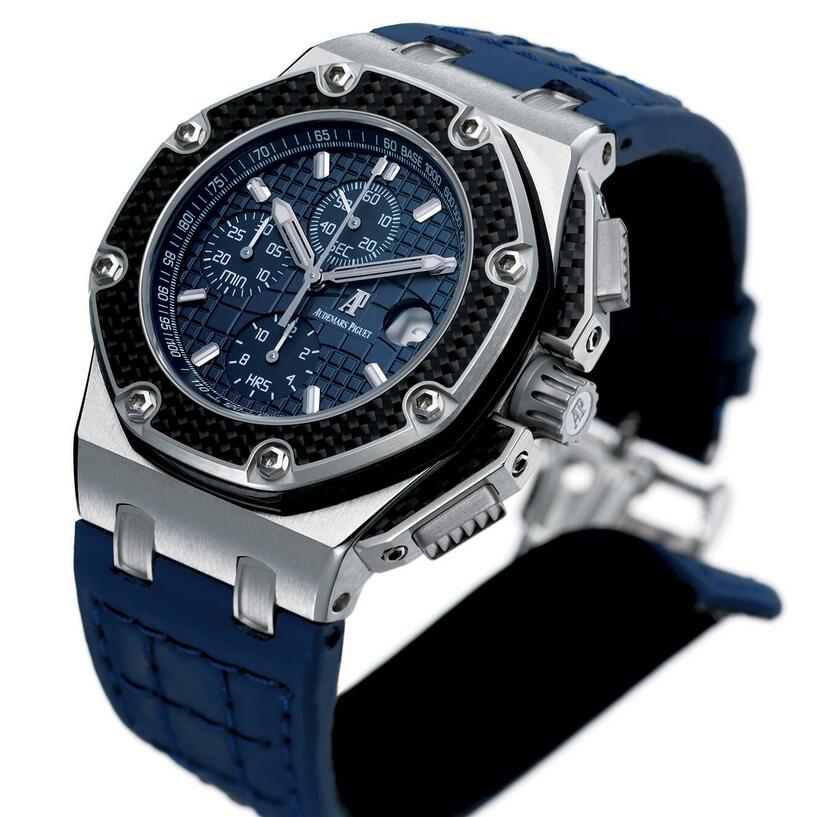
The hands also deserve special attention. The hour and minute hands have generally retained the original baguette shape that Gerald Genta preferred. However, Octavio Garcia decided to make the hands wide, skeletonized, and even latticed on some models, which is quite in line with the aggressive, sporty style of the 1:1 replica watches. The embossed tapisserie motif that usually adorns the dials of RO and ROO was not left untouched. On the ‘Montoya’, the central part of the dial was decorated with a relief image of a checkered racing flag – a kind of wavy tapisserie pattern. It looked like the Windows logo. For this reason or another, Audemars Piguet later refused to use such a dial decoration.
In this context, it is worth noting that Octavio Garcia’s ingenuity is combined with incredible flexibility in design. With all the numerous Offshores he has designed, it seems that he has easily discarded some choices in favor of others; in the next iteration, he returns to the previous versions, without getting stuck on the only idea that once attracted him.
In China AAA fake Audemars Piguet watches, the movement is of no small importance. In all Offshores before the ‘Montoya’, it was actually ignored – simply because the ROO always had a solid caseback. It was not until 2004, in the eleventh year of the collection, that it was decided to add a sapphire window to the caseback of the ROO ‘Montoya’. Octavio Garcia, the master of details, designed a self-winding rotor for the caliber with five openings especially for this watch.
At that time, the Offshores did not use in-house movements – instead, the basic automatic caliber 2226 from Jaeger-LeCoultre and the Dubois Dépraz 2480 chronograph module were supplied. With the ROO ‘Montoya’, for the first time the watch owner has the opportunity to view the caliber.
Meanwhile, it is common to equip a mechanical watch with a sapphire crystal caseback, which is certainly justified if the movement is really good, and the Offshore’s caliber is very good. Finally, you should also consider the ‘Montoya’ strap. During his career at Audemars Piguet, Octavio Garcia had a lot of experience in inventing different racing straps. In particular, the ‘Montoya’ strap is decorated with meshes in a contrasting (titanium model) or non-contrasting (gold and platinum models) color – this design could have been called “tapisserie” at Audemars Piguet, but it wasn’t.
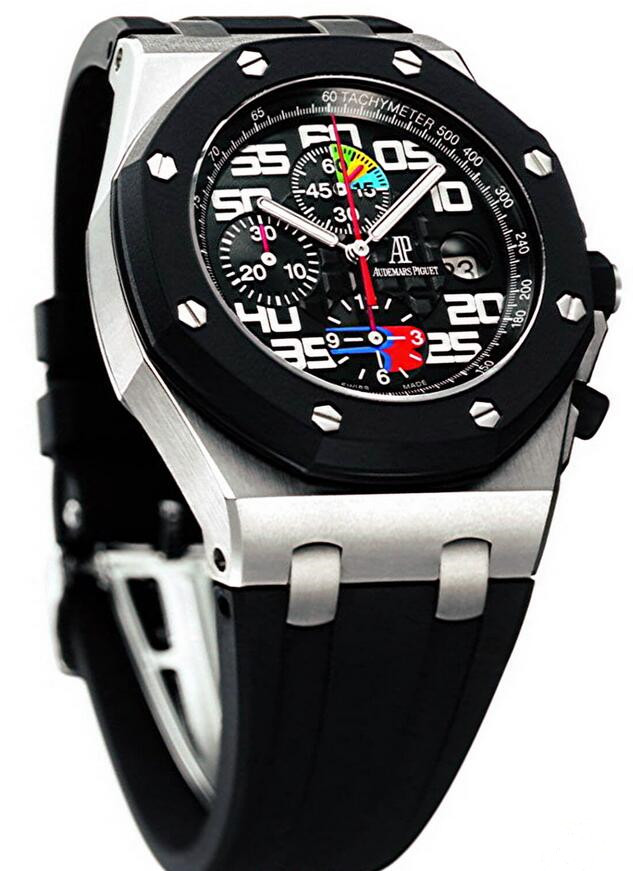
All three versions of the online replica Audemars Piguet Royal Oak Offshore ‘Juan Pablo Montoya’ watches were enthusiastically received by the public, so the next ROO F1 was not long in coming: in 2005, the first watch dedicated to Rubens Barrichello appeared. With the ROO ‘Barrichello’, Octavio Garcia brings the classic ROO case to the ROO F1 line, drawing all the attention to the dial. This tactic continued when, after the avant-garde futuristic Grand Prix style models, as we will see later, there are alternating models with the original ROO case design from 1993.
Apart from the ‘traditional’ 1993 case, the ROO ‘Barrichello’ super clone watches for sale is most interesting for its dial. It is quite crowded. The colors of the Brazilian flag (Barrichello is Brazilian) are reflected in the design of the small seconds dial, the 12-hour counter is decorated with the blue and red logo of the racer, but the most striking feature of the watch is the minute scale on a chapter ring with large 5-minute numerals replacing the hour markers.
Please note that Audemars Piguet adopted this design eleven years before the release of the Rolex Air-King 116900, which is known for its mixed large hour and minute numerals. A matte black bezel with rubber coating, similar to the Royal Oak Offshore Chronograph ‘Rubber Clad’ models, gives the ROO ‘Barrichello’ watch more contrast and accentuates the dial. Audemars Piguet later abandoned the rubber coating on the bezel.
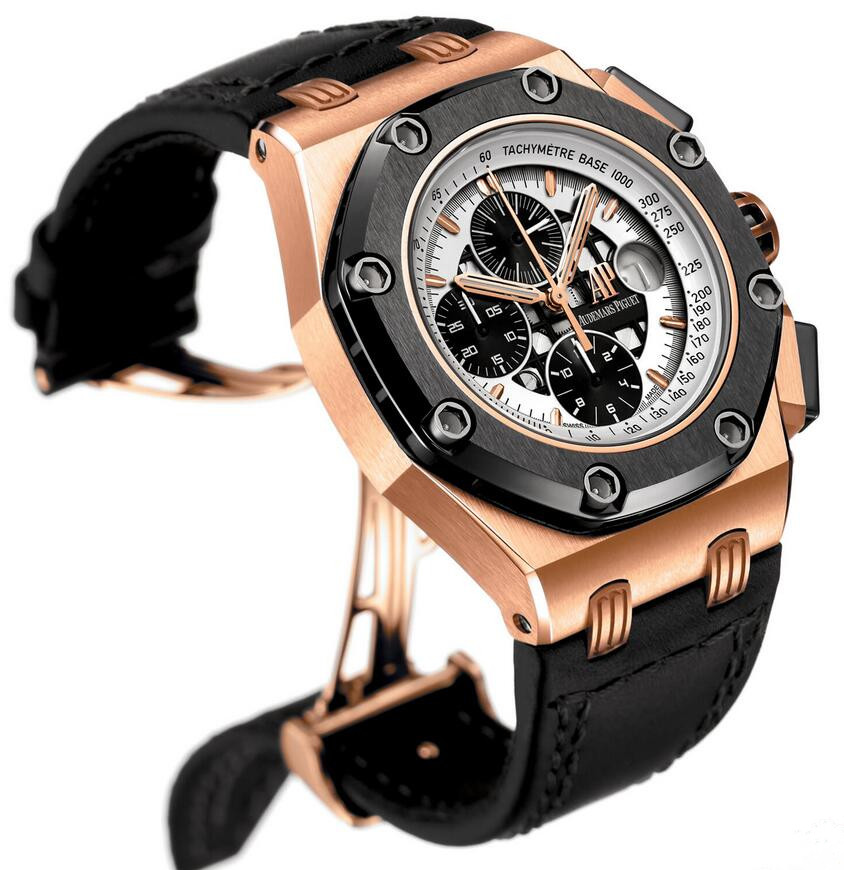
The following year, 2006, Audemars Piguet’s collaboration with Rubens Barrichello continued. The brand’s management and Octavio Garcia decided to return to the experimental futuristic design of the ROO ‘Montoya’ and continue in this direction, complementing the Offshores of the standard original design, which Audemars Piguet replica watches for men had not abandoned, with models in the hi-tech futuristic racing style. Royal Oak Offshore ‘Rubens Barrichello II’ was the name of the new watch, which had little in common with the first version of the ROO ‘Barrichello’. ROO ‘Barrichello II’ was presented to the public not at the SIHH Geneva watch show in January, as was customary, but on August 23, 2006, at the Turkish Grand Prix in Istanbul where, incidentally, Barrichello finished unsuccessfully in 14th place.
From a technical point of view, the biggest highlight of the Royal Oak Offshore ‘Rubens Barrichello II’ was the introduction of zirconium ceramic – a material that is futuristic, high-tech, durable, and above all, scratch-resistant. In this watch, the bezel, chronograph buttons and crown insert were made of ceramic, giving the watch an even more pronounced technical character.
In addition, a new type of dial was invented especially for this watch, called ‘Racing’ – Méga Tapisserie Racing. What made it special was that instead of the méga tapisserie relief pyramids that are standard at ROO, a lattice openworked structure was used. Therefore, on a ROO watch, there was the rare opportunity to see the underlying chronograph module through the dial, albeit only partially.
The broad hour and minute hands were also skeletonized, similar to the ROO ‘Montoya’ watch. The result was impressive, as the structure of the dial turned out to be complicated and three-dimensionally multi-layered – from the chronograph module to the obligatory inclined outer dial ring with a tachymeter scale.
In 2008, the ROO F1 line was expanded with a third and unfortunately last version of the Audemars Piguet Royal Oak Offshore fake watches online, dedicated to Rubens Barrichello. The ROO ‘Barrichello III’ was presented to the public in May 2008 and again at the Turkish Grand Prix. This time there was a good reason for the choice of venue: by taking part in the Istanbul race, Rubens Barrichello broke the record held since 1993 by Italian Formula One driver Riccardo Patrese, who competed in 256 races during his career from 1977 to 1993. The Turkish Grand Prix was Barrichello’s 257 start, so the watch was produced in a limited edition of exactly 257 pieces. For this reason, it was sometimes called the Royal Oak Offshore ‘257’.
The Royal Oak Offshore ‘257’is essentially a revised version of the ROO ‘Barrichello II’ in rose gold. While the crown, chronograph pusher guards and strap attachments of the “Barrichello II” watch are made of rose gold, they are made of titanium on the ‘Barrichello III’. The chapter ring has changed its color from silver to red and the black alligator leather strap is stitched with a red thread to match the dial color.
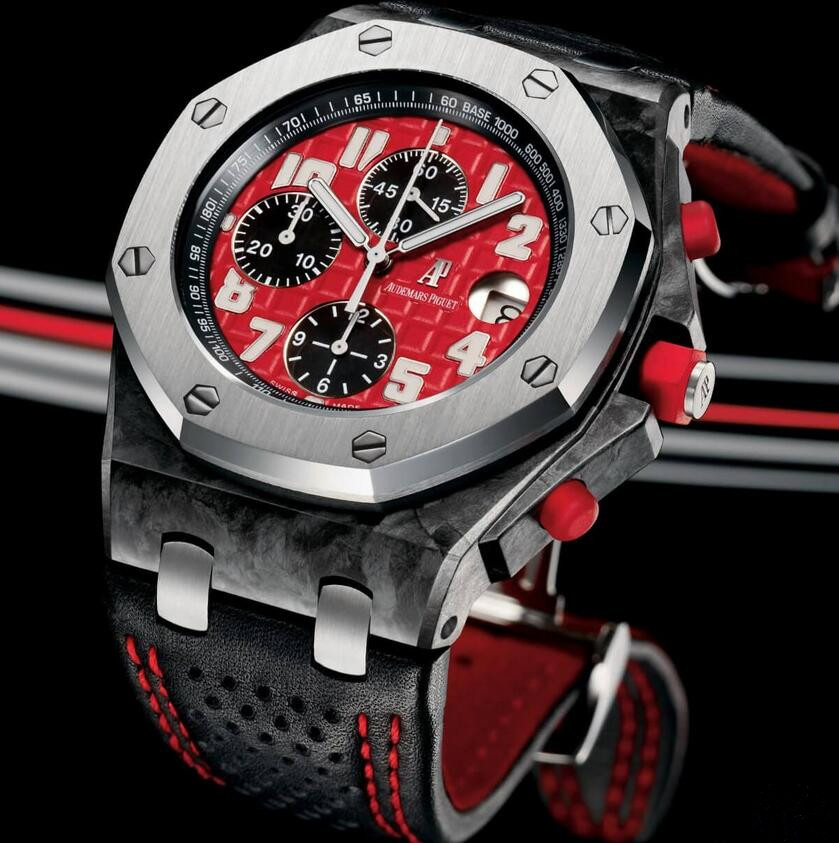
The story of Offshore racing replica watches site continued in 2008, when the brand introduced the Royal Oak Offshore ‘Singapore Grand Prix’ Chronograph, released in honor of the very first Formula 1 night race in Singapore. This is the first watch from the Offshore racing series equipped with a movement based on the automatic manufacture caliber 3126.
Unfortunately, it is not possible to check it with your own eyes, as the caseback is solid. There is no dedication to Singapore on the dial, which is correct, as the caseback is more suitable for this purpose. The dedication takes the form of a commemorative caseback with the image of a race car in relief, followed by the inscriptions “Royal Oak Offshore Limited Edition” and “Singapore GP 2008” required for the occasion.
The ROO ‘Singapore Grand Prix’ is an excellent example of a special edition that achieves maximum results with minimal means. Minimal in the sense that the design is based on the original 1993 version of the Royal Oak Offshore, as was the case with the ‘Barrichello I’ watch. The night racing theme was expressed through the aggressive red and black color scheme of the watch: with the forged carbon case ring, the outer ring of the dial with the tachymeter scale, the chronograph counters and the perforated racing leather strap in black; and with the signature méga tapisserie dial, crown, pushers, strap lining and double stitching in red.
The general theme of the F1 World Championship in the ROO collection does not stop with ROO, created in honor of the Formula 1 race in Singapore. The year 2010, which traditionally began for the brand in January at the SIHH in Geneva, was marked by the launch of the new line of fake watches shop with futuristic racing design, which includes three new Royal Oak Offshore ‘Grand Prix’ models. They are not the first futuristically designed watch in the Formula 1-inspired line, and it is easy to find in it many features of the previous ROO F1 models.
The question of which watch was chosen as a prototype in the development of the ROO ‘Grand Prix’ does not arise. Obviously, it is ROO ‘Barrichello II’. I will refrain from a boring enumeration of the relevant features, preferring to draw attention to the differences. There are many, and they are obvious. Let’s start with the dial. For the ‘Barrichello II’, an openworked version of the méga tapisserie motif was developed, while the ROO ‘Grand Prix’ uses a unique inverted relief that will probably remain the only one of its kind, as Audemars Piguet has abandoned the inverted relief in favor of the classic ‘positive’ méga tapisserie relief.
The Royal Oak Offshore ‘Grand Prix’ has an extremely unusual bezel – nothing like it was made by Audemars Piguet before or since. First, it consisted of an upper part made of carbon and a lower part made of ceramic. Second, the bezel featured lateral channels that look like the ventilation ducts of a formula car – this technical association may have later given rise to the idea for the acoustic ducts on the back of the Royal Oak Concept Supersonnerie Repeater case, which ensure that sound vibrations are effectively diverted away from the watch case to the outside.
The carbon/ceramic bezel is found on all three ‘Grand Prix’ models – made of forged carbon (Ref. 26290IO.OO.A001VE.01, limited edition of 1750 pieces), rose gold (Ref. 26290RO.OO.A001VE.01, 650 pieces) and platinum (Ref. 26290PO.OO.A001VE.01, 75 pieces). The carbon parts (I prefer to call this material a carbon fiber composite), made with the precision forging technique developed by Audemars Piguet, give the ROO ‘Grand Prix’ an appropriate high-tech character. As a bonus, the owner of the watch receives a unique image formed by the carbon fibers on the surfaces of the case, a kind of fingerprint. This image can even be used to identify the watch if necessary.
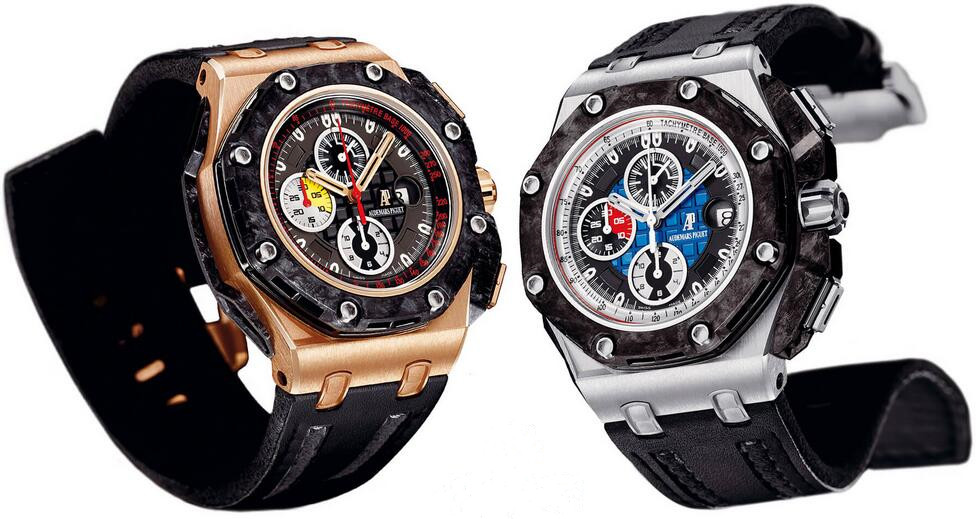
The protective parts (“square jaw”) for the crown and chronograph pushers of the gold and platinum ROO ‘Grand Prix’ models are also made of carbon, while the pusher guards of the carbon model are made of titanium. The unprecedented ‘wing’ on the left side of the case is also made of carbon. It looks like a counterpart to the protective parts of the crown and chronograph pushers. The triangular cutout in the lower left corner of the case seems to be a complete mystery – it has no visible reason and contradicts the symmetry of the design. This feature and the side ‘wing’ of the case, have never been seen on any other Offshore.
To sum up the review of the Royal Oak Offshore ‘Grand Prix’, the richness of detail, ingenuity and thoughtful finish of this watch stand out even from the diverse racing series of the ROO collection and once again make me admire the talent of Octavio Garcia, the father of modern Offshores and a true master of delicious details.
The carbon fiber composite, extensively used in the Royal Oak Offshore ‘Grand Prix’ replica watches store, appeared again in 2010 in an Offshore developed from the original design from 1993 – the Royal Oak Offshore ‘Jarno Trulli’ Chronograph. Unveiled in October at the Japanese Grand Prix, it was the result of a collaboration between Audemars Piguet and Italian Formula One racing driver Jarno Trulli. This driver is clearly not one of the title winners.
He became famous, if only for a resounding victory in the 2004 Monaco Grand Prix, the same race in which Jaguar team driver Christian Klein crashed his race car into the guardrails of a corner and the diamond on the nose of his car, set as an advertisement for the movie “Ocean’s Twelve,” mysteriously disappeared without a trace.
Everything about the ROO ‘Trulli’ was ostentatiously high-tech: a case ring made of carbon fiber composite, a caseback, chronograph pushers and a crown made of titanium, a bezel made of cermet. This material, which appeared for the first time in the ROO collection, was chosen as an alternative to the zirconia ceramic normally used in Swiss made fake watches. Cermet is just as scratch resistant as zirconia ceramic, maybe a little less, and it resembles a very dark and durable metal.
This is the reason why the bezel made of cermet was tested on the ROO ‘Trulli’. Today, this experience must be considered unsuccessful, because apart from this watch and some subsequent ones, the cermet has disappeared from the collection – like the diamond of the Christian Klein racing car.
The dark grey dial of the Royal Oak Offshore Jarno Trulli with silver counters features red accents – hour markers, hour, minute and central seconds hands that distinguish the ROO ‘Trulli’ from all other Offshore racing replica watches paypal at first glance.
The culmination of the Formula 1 theme in the Royal Oak Offshore collection took place at the end of November 2010, when Philippe Merck, then CEO of Audemars Piguet, announced the start of a collaboration with the great Michael Schumacher at a press conference in Duesseldorf. The watch world received the news with great interest, but the ‘Schumacher watches’ or ‘Schumi’ as collectors usually call them did not appear immediately – only two years later, in October 2012. Already traditionally, the release consisted of three models – high-tech (here – titanium, 1000 pieces), traditionalist (rose gold, 500 pieces) and luxury (platinum, 100 pieces).
The prototype of all three ‘Schumi’ is obvious – again it is the excellent and unforgettable ‘Barrichello II’ – in the ROO collection Rubens Barrichello was the first on the imaginary track, unlike most of the competitions of Ferrari teammates on real race tracks. The ROO ‘Schumi’ bezel is scratch-resistant and made of cermet. All models have titanium protective parts for the crown and chronograph pushers a la ROO ‘Grand Prix’. The crown was replicated from the same watch.
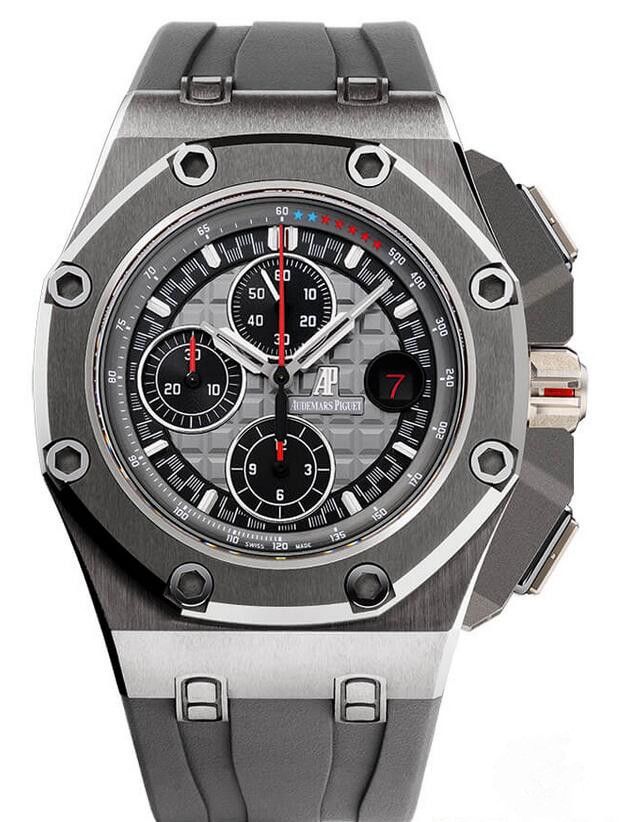
To honor a new brand ambassador, a special dial design was made for ROO ‘Schumi’. The seven stars at the top of the tachymeter scale represent the driver’s victories: two blue stars for two world championship titles with Benetton and five red stars for five titles with Ferrari. The peripheral scale is designed in racing style with a checkered 1/5-second track. The hour and minute hands of a new faceted shape was developed for this edition. The red color of the chronograph hands was complemented by the red color of the date display numerals, which are on a black background – note that the date ring background is usually white on Offshores.
The collaboration with Michael Schumacher was supposed to continue, but the tragic accident of the great racer on the ski slope made it almost impossible. However, Audemars Piguet felt it necessary to continue the development of a special chronograph wristwatch, the complication of which was suggested by Michael Schumacher himself – this task was completed in 2015 with the release of the Royal Oak Concept Laptimer Michael Schumacher Flyback Chronograph watch. However, this watch was released in the Royal Oak Concept collection, which is why I only mention it here.
Also in 2012, another Audemars Piguet ROO fake watches online store was unveiled, made in collaboration with a Formula 1 racing driver. We are talking about the Swiss Sébastien Buemi, who has been an ambassador for the brand since 2009, and the Royal Oak Offshore ‘Sébastien Buemi’, which was released in his honor. As has often been the case, a racing ROO with a futuristic design was often followed by a racing ROO with an original design from 1993, of course in a special version.
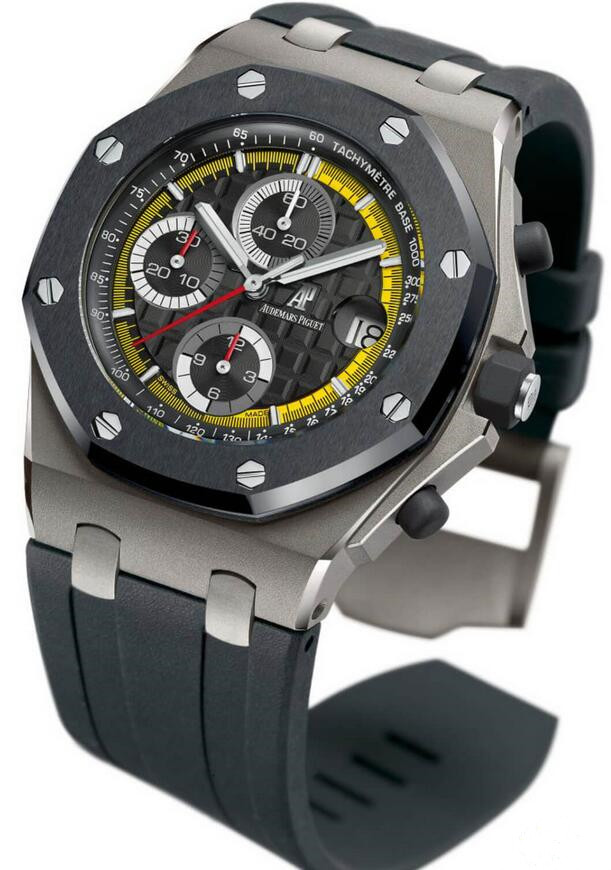
So, it was also in this case. For the ROO ‘Buemi’ was made in original ROO design, a polished titanium case, a ceramic bezel and a calm dark grey dial with yellow markings on the second scale were chosen – yellow was the main color in the coloring of Buemi’s racing helmet. Sébastien Buemi’s career in Formula 1 ended in 2012, and in the same year Audemars Piguet was headed by François-Henri Bennahmias, who stopped producing racing Audemars Piguet Royal Oak Offshore replica watches wholesale; thus ROO ‘Buemi’ was the last watch in this line. Apparently, Bennahmias simply allowed what was started under Philipp Merck, the former CEO, to be finished. In 2015, Octavio Garcia, the art director and designer of all the Offshores described here, left Audemars Piguet. The limited-edition racing Offshores has finally and irrevocably become a classic collectible.
